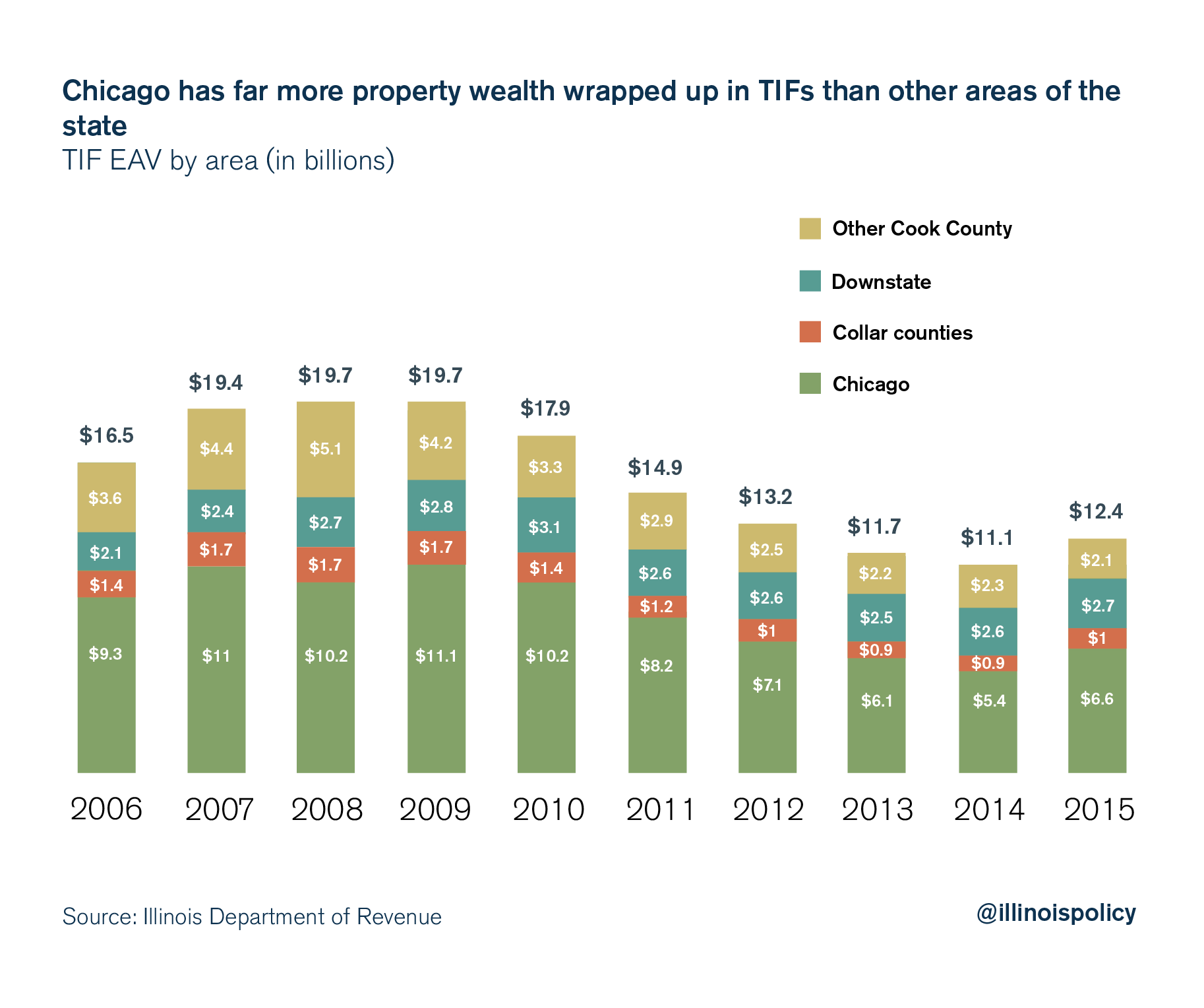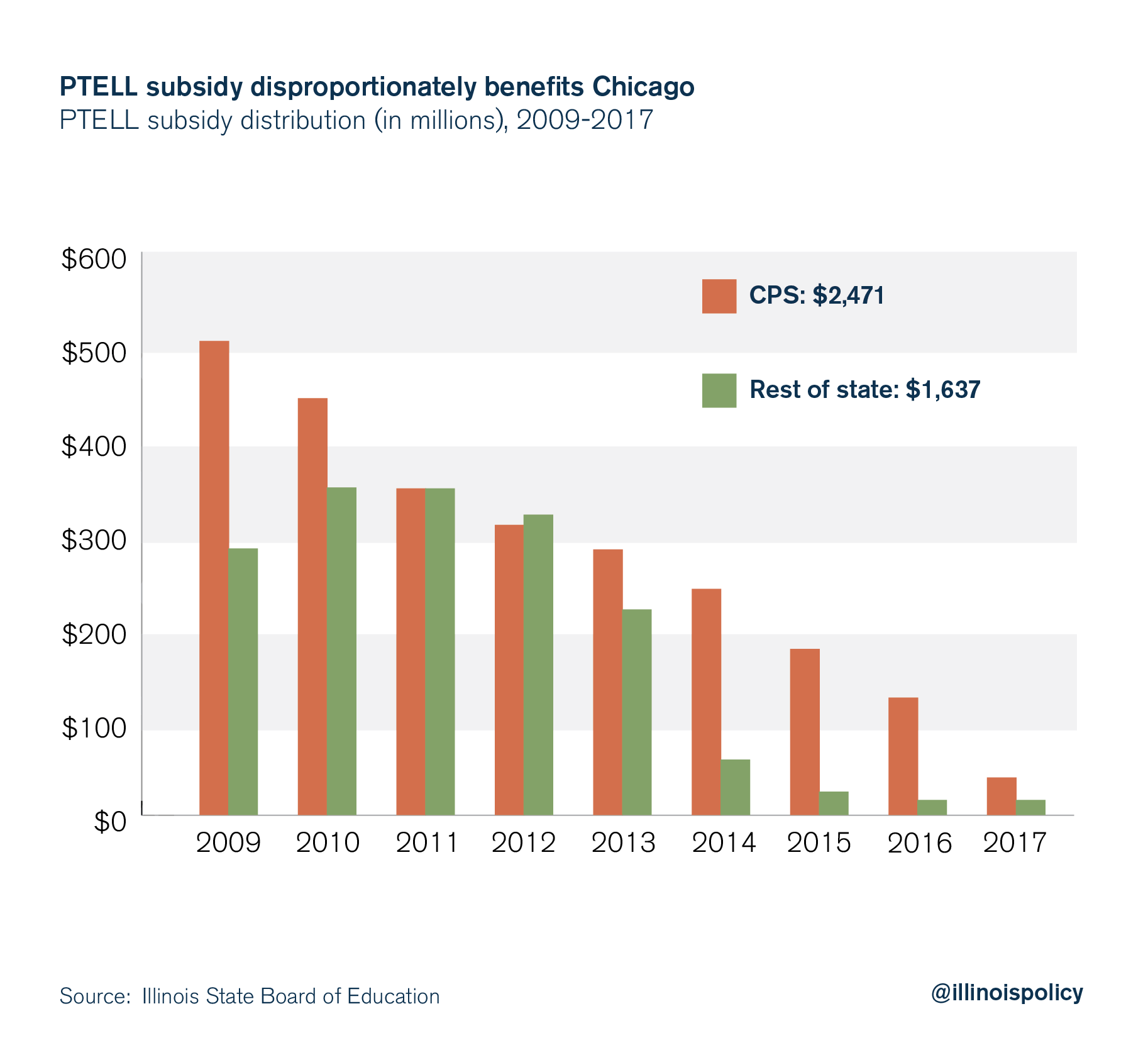How TIFs and PTELL warp fairness in school funding
Lawmakers concerned with fairness within Illinois’ education system should eliminate discriminatory subsidies.
For years, proponents of a new education funding formula for Illinois have talked about bringing equity and fairness to education finance. Gov. Bruce Rauner took a major step toward that goal when he used his amendatory veto power to strip Senate Bill 1 of some of the most unfair and inequitable practices within the formula: subsidies related to Illinois’ Property Tax Extension Limitation Law, or PTELL, and tax increment financing districts, or TIFs.
Since 2000, school districts that are part of economic development zones called TIFs have been allowed to do something that non-TIF districts can’t – hide large amounts of their property wealth from the state when applying for aid for education.
School districts that can reduce their overall property wealth when applying for state aid look poorer, resulting in more aid from the state. So for every additional dollar the state gives to districts located in TIFs, it’s one less dollar the state can give to districts without TIFs.
Chicago Public Schools, for example, now has more than $6.6 billion of property wealth tied up in TIFs that it will keep off of its aid request to the Illinois State Board of Education, or ISBE. As a result, the state will give CPS more aid than it would have had CPS reported all the property wealth in its district.
In a 2013 report, the Illinois Policy Institute calculated that the 2011 TIF subsidy for CPS, holding everything else equal, was worth $265 million that year alone. More money for CPS meant $265 million less for districts throughout the state.
A similar practice of underreporting property value occurs for school districts operating under property tax caps, known as PTELL districts. Districts subject to PTELL also get to underreport their property values when asking for state aid.
ISBE has for years calculated and reported the financial impact of PTELL subsidies. The results reveal a system that’s strikingly unfair. The districts that can hide their wealth have, in some years, taken up to $800 million in subsidies from districts that can’t. And those subsidies have largely been limited to a select number of districts.
In 2009, when the PTELL subsidy was at its peak, CPS took in $505 million in subsidies at the expense of most districts statewide.
Awareness that PTELL and TIF subsidies disproportionately benefit some districts – and ideas for reform – are nothing new in education finance circles. Then-Gov. Pat Quinn’s Taxpayer Action Board highlighted the issue in 2009, and the Taxpayers’ Federation of Illinois brought the issue further to light in 2010. (Ted Dabrowski was a contributor to both reports.)
For too long, districts that aren’t affected by property tax caps or TIFs have been forced to subsidize the local property tax decisions of districts that choose to cap themselves or use TIFs.
Rauner was right to eliminate the unfairness of PTELL and TIF subsidies in his amendatory veto of SB 1.
To be clear, the governor’s veto ensures no district will get less funding in 2018 when compared with what that district received in 2017. The governor’s removal of PTELL and TIF subsidies only affects how new, additional dollars are distributed under the new education funding formula.
Why PTELL and TIF subsidies are unfair
The creation of local economic development zones and property tax caps is very much a local decision.
Take the city of Chicago. When Chicago officials create a new TIF district they are consciously deciding to keep future property wealth inside a development area. Officials know that will mean less future property wealth that CPS can count on for revenue.
But it’s not as if that property wealth is suddenly missing from Chicago. It’s just been directed away from CPS for another purpose. So, when the state provides Chicago with the TIF subsidy, the city as a whole is getting more than it’s entitled to.
Chicago is taking money out of its left pocket and putting it into its right pocket, then complaining that its left pocket has less money.
But downstate districts that don’t have TIFs, such as Palestine Community Unit School District No. 3, don’t care that Chicago is using its property wealth to create economic development areas. All Palestine CUSD No. 3 knows is that it is getting less money from the state because of Chicago’s subsidy.
The same goes for PTELL districts. Communities can use PTELL to cap their property taxes, but then ask the state formula to make up for what their districts are losing by giving them more state aid.
As with TIFs above, local officials want to have their cake and eat it too. They want their property taxes capped, but want somebody else to subsidize their education costs.
This is fundamentally unfair to school districts that aren’t receiving PTELL or TIF subsidies. They lose out because the total state aid pool is diminished by PTELL and TIF subsidies. In other words, every dollar the state spends on subsidies to PTELL and TIF districts is a dollar that should have been evenly distributed to all districts across the state.
Over the past decade and a half, non-PTELL and non-TIF districts have been unfairly deprived of billions of dollars.
PTELL districts alone have attracted over $7 billion in special subsidies since 2000, according to ISBE.
The unfairness of TIFs
At their height in 2009, nearly $20 billion of property value statewide was located in TIFs and therefore excluded from school districts’ local property wealth. The amount of property wrapped up in TIFs has fallen since then, but the amount remains substantial. Over $12 billion in property value across Illinois remained in TIFs in 2015.

More than half of those TIF values are in Chicago alone. That’s been the case for more than a decade. CPS in 2015 had $6.6 billion locked up in its TIFs, while the rest of the state had just $5.7 billion.

When measured on a per-student basis, CPS as a “region” is allowed to exclude far more TIF property than the other key areas of the state.
Based on the most recent Illinois Department of Revenue data, CPS had $6.6 billion in property wealth in TIFs in 2015. That’s nearly $19,000 per student.
Meanwhile, the average district in the collar counties has just $1,800 in TIF property wealth per student.

Being able to exclude so much property means more in state subsidies for TIF districts.
For example, the TIF subsidy for CPS in 2011, holding everything else equal, was worth $265 million that year alone. And more money for CPS meant $265 million less for districts throughout the state.
The unfairness of PTELL
Similarly, school districts subject to PTELL (property tax caps) also get to underreport their wealth.
ISBE has reported the special benefits of PTELL by year, and there’s been one clear winner – CPS.
Take 2009, for example. The PTELL subsidy that year totaled nearly $800 million to school districts in property tax-capped areas. CPS received $505 million of that subsidy.

The 2009 Taxpayer Action Board asked ISBE to run state aid without the $789 million PTELL subsidy for fiscal year 2009. The board reported the following conclusion from that analysis: “Without PTELL adjustments in 2009, the State could have increased its contribution to the foundation level in 2009 by over $700, from $5,959 to $6,678 per pupil, coming close to the recommended level of $7,000 per student.”
In short, the PTELL subsidy has for a long time robbed the state from having a much higher foundation level for all students across the state.

Measured in other terms, CPS received nearly $1,500 per student in subsidies in 2009, when the PTELL subsidy was near its peak. The rest of the districts in Illinois received just $183 per student.

As property values have fallen from the heights of the mid-2000s, so too has the total size of the PTELL subsidy. But Chicago still receives the vast majority of the existing subsidy.
In 2017, over $40 million of the $56 million in total subsidies went to CPS.
In per-student terms, CPS received $114 in subsidies. The rest of the districts in Illinois received less than $10 per student on average.

And while proponents of retaining the PTELL subsidy promote it as a broad benefit, in reality its impact is concentrated in just a few districts. For example, in 2013, though 291 districts benefited from the PTELL subsidy, just 54 districts consumed 90 percent of the $502 million it provided that year.
Proponents of SB 1 fail to focus on real fairness
Advance Illinois, one of the advocacy groups engaged in drafting SB 1 and defending the unfair TIF and PTELL subsidies, is calling the governor’s amendatory veto unfair by promoting the graphic below.

The graphic highlights the districts that are in an area with PTELL or areas with both TIFs and PTELL. Advance Illinois wants residents to focus on the districts in orange, which they say will be “less eligible for state aid” due to the governor’s amendatory veto.
But the governor’s amendatory veto does not mean less money for districts when compared with 2017. Every district is protected in 2018 by a “hold harmless” provision that ensures the districts get at least the same amount as in 2017.
And Advance Illinois is overstating the number of districts that would be affected by ending the PTELL subsidy. As shown earlier, while there are hundreds of districts subject to PTELL, only a portion of those districts ever actually receive a PTELL subsidy. For example, in 2017 there were over 456 districts subject to PTELL, but only 82 districts received the subsidy.
Rather than focus on the districts in orange, the real focus should be on the districts in gray. They have been losing state aid to many of the districts in orange for more than 15 years.
By removing TIF and PTELL subsidies from the SB 1 funding formula going forward, the districts in gray will no longer have to subsidize the TIFs and property tax caps in the orange districts, bringing more fairness to the funding formula.
State Sen. Andy Manar, D-Bunker Hill, fundamentally misunderstands this point.
One of the central proponents of SB 1, Manar has gone on record criticizing the governor’s removal of TIF and PTELL subsidies from the bill, saying communities with PTELL and TIF “shouldn’t be punished” for having them.
But removing PTELL and TIF subsidies isn’t about “punishing” those districts with TIFs and PTELL. It’s about being fair to the districts that have been forced to subsidize TIF and PTELL for the past 17 years. Furthermore, even communities with PTELL and TIF will receive at least as much state funding as the previous year under the bill’s hold harmless provision.
The impact of Rauner’s veto
Rauner’s changes to PTELL and TIF will bring back fairness to the funding formula and are unlikely to have a dramatic impact in the short term. Because of the hold harmless provision, districts will only see a difference as marginal dollars are added to education funding.
Here are some of the immediate impacts of the PTELL and TIF amendments:
- First, no district will get less funding than it received last year. The governor’s amendatory veto maintains SB 1’s original per-district hold harmless provision through the 2020-2021 school year, so whatever subsidies districts were getting at the expiration of the existing formula have been baked into the hold harmless provision.
- Second, the governor’s removal of PTELL and TIF subsidies only affects how new, additional dollars are distributed under the new education funding formula. All districts in Tier 1 and Tier 2 (the tiers first in line for new money under the new formula) will continue to receive new money, but depending on their reliance on the subsidies, some will see more than others.
- Third, the overall impact of the amendatory veto will actually boost many districts’ new funding from the state. The veto’s impact on CPS, from the elimination of TIF and PTELL subsidies, to the reduction of the $200 million in “block grant” funding, to the removal of the clause that lets CPS subtract its annual legacy pension costs from its local resources, will generate more new dollars that will be redistributed to districts across the state. Because of these changes, some districts with TIFs or PTELL will come out ahead.
While it’s not possible to know the full outcome of the SB 1 amendatory veto changes until ISBE reruns the numbers, Illinoisans do know the following: No district will receive less state aid than it did last year. And every non-PTELL and non-TIF school district is going to benefit from the removal of the PTELL and TIF subsidies.
Rauner was right to introduce amendments to end those subsidies, which have unfairly benefited some Illinois districts at the expense of others for more than 15 years.
For additional reading on Illinois’ education funding formula and evidence-based funding, see the following:
Report of the Taxpayer Action Board
Taxpayers’ Federation of Illinois April/June 2010 Tax Facts
Special report: Illinois education finance solutions
Illinois school district consolidation provides path to efficiency
Understanding Illinois’ broken education funding system
CPS pensions: From retirement security to political slush fund
Evidence-based education funding doesn’t work, would cost Illinois taxpayers billions

